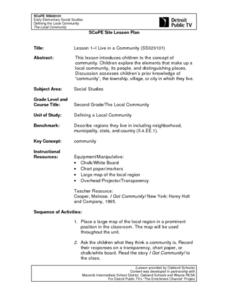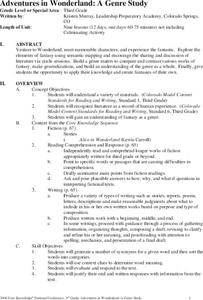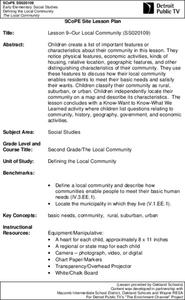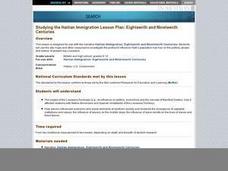Curated OER
Lesson 1-I Live in a Community
Second graders brainstorm the concept of a community and all the elements involved in the make up of one. They pull from the resources on the community that they already live in or have lived in. In addition, they share their reflections...
Curated OER
Mercer Mayer 1: Guided Reading and Using Concept Maps
Students observe a model classroom of children working in a cooperative group activity. After the video, students discuss how cooperative group learning is used to be most effective. They explore the effectiveness of giving well thought...
Curated OER
Adventures in Wonderland: A Genre Study
Students explore the concepts of fantasy writing through this nine lessons unit. The unit presents semantic mapping, discussions, comparisons of various works of fantasy, and the opportunity to create their own fantasies.
Curated OER
Children's Literature
Introduce the students to basic economic concepts and types of economic systems and develop the an understanding of how economic choices involve costs and consequences; provide introduction to rural America circa 1920 and compare to our...
Curated OER
Concept Mapping
Students develop a concept map about transportation. They connect the use of cars to different subjects. They share their findings with the class.
Curated OER
Organizing A Corporation And Paying A Dividend
Students engage in a lesson that is concerned with the establishment of a corporation. They apply accounting principles to different situations in order to make payments on a dividend. Students also investigate the basic accounting cycle.
Curated OER
Lesson 9-Our Local Community
Second graders brainstorm and create a list of important features/characteristics that they would want to include in a community setting. They include physical features, economic activities, kinds of housing, etc. This lesson is a...
Curated OER
Hachimaki/Shibori Lesson Plan
Sixth graders are introduced to the technique of Arashi Shibori and its history. In groups, they discover how to perform this process and examine how to do hachimaki. To end the lesson, they make their own hachimaki to wear and share it...
Curated OER
Mapping Your Neighborhood
Pupils define and outline their neighborhoods using GIS (geographic information systems) or a regional map and relate their neighborhoods to the principles of Smart Growth.
Curated OER
The Seasonal Round and The Cycle of Life
Fourth graders are introduced to the concept of the seasonal round and how folklife traditions vary from season to season. They begin charting dates of personal interest on seasonal round calendars by starting with birthdays. Students...
Curated OER
Studying the Haitian Immigration: 18th and 19th centuries
Students read a narrative and conduct extensive research to determine how Haiti's population has had an influence on the social, political, and economic culture of present-day Louisiana. As a culminating activity, students write papers...
Curated OER
Life Is a Journey
Students consider the literal and figurative definitions of the word journey. In this metaphor lesson plan, students discuss life journeys and their diversity.
Curated OER
Around The Town
Students participate in alphabetizing letters, coming up with questions and concepts, and show the rules of phonics by playing a game for a unit opener. In this language arts lesson plan, students also come up with thinking maps.
Curated OER
Floating Plates on the Earth
Fourth graders construct a concept map about Plate Tectonics. They include types of movement, names and effects of boundaries. They research plate tectonics, describe and name 3 types. They analyze the effect on the earth's surface of...
Curated OER
Pennsylvania Watersheds
Young scholars identify the major watersheds of Pennsylvania. In this forestry lesson, students learn what a watershed is and are assigned one of the major watersheds of Pennsylvania. Groups then need to determine the boundaries of the...
Curated OER
How Has Math Evolved?
Eighth graders pick a topic or person to research related to the history of mathematics. They brainstorm and create a concept map, using the multimedia software inspiration, about what they are researching and want to examine. They then...
Curated OER
The Birds and the Beaks
Young scholars explore the adaptations that birds have. In this adaptations lesson students view a video and create a concept map of birds and their adaptive traits.
Curated OER
Hot n' Cold
Students keep a weather log. For this weather and temperature lesson, students discuss the information that can be obtained from a map and lead into a discussion about temperature. Students watch a video about temperature and...
Curated OER
It's a Beautiful Day in MY Neighborhood
Young scholars create and produce their own "WAlk Through" video about their neighborhood, develop script writing and on-camera narration skills, and gain knowledge and expertise about the landmarks in their own neighborhoods.
Curated OER
A STEP IN SPECIATION
Students place different subspecies of a CA salamander are placed on grid map of CA according to where samples were collected. Then discuss patterns of their distribution, their likely evolutionary relationships, and probable sequence of...
Curated OER
An Internet Activity for The Introduction Of The Civil War
Students research, using the Internet, specified Civil War battles in order to prepare an oral presentation for the class. They, in small groups, present using images and maps. They take a quiz on the subject matter and evaluate the web...
Curated OER
Infrared-Hot
Students describe how the sun heats the Earth, explain the nature of infrared light, explain how thunderstorms are formed and use infrared maps to predict severe weather.
Curated OER
Where Is Japan? How Are We Alike And Different?
First graders use literature, maps, and globes to explain how physical environments in various parts of the world are similar to and different from one's own, and that certain areas have common characteristics and can be called regions.
Curated OER
Pennsylvania Colony
Students research the main reasons for the colonists moving to the Pennsylvania colony. They analyze maps, label a bubble map, list similarities/differences of immigrants then and now, and create a colonial newspaper advertisement.

























